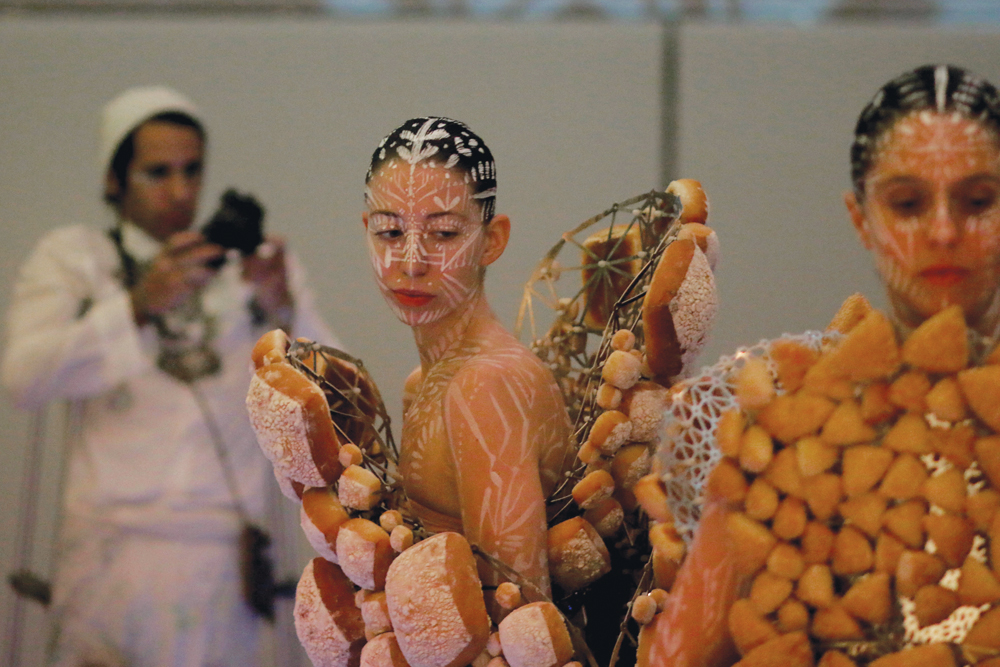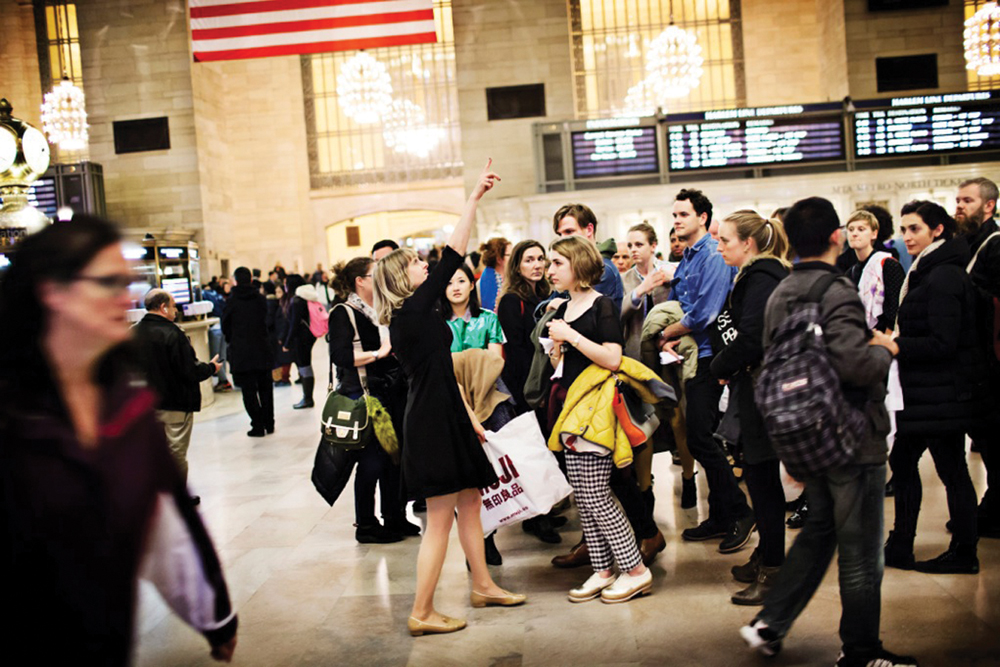« Reviews
Performa 13
Various venues - New York City
By Vanessa Albury
Referencing the Venice Biennale’s garden pavilion structures, Performa 13’s Pavilions Without Walls continues to shape Performa as an internationally attuned and attended performance art biennial with a transient presence housed by New York City. The Performa Hub hosts daily contextual and background presentations like curators Johanne Nordby Wernø and Solveig Øvstebø discussing the Norwegian art scene, which is almost never privately, but primarily government-sponsored. Most shows sell out to see some 40 established and emerging artists creating new performances or reproductions of infamous past works that would otherwise remain art world memories, like Martha Graham’s Herodiade and Spectre-1914. Watching Graham’s dancers move through Isamu Noguchi’s skeleton-like sculptures reveals a contemporary dearth of intricate collaboration between visual art, dance and theater. Performa 13 revels in blurring the lines between these art milieus.

threeASFOUR, Fest, presented as part of Performa 13 by The Jewish Museum. Photo: Chani Bockwinkel. Courtesy of Performa.
The fashion trio threeASFOUR presents “Fest” at the Jewish Museum, which dovetails harmoniously with their Mer Ka Ba installation of 3D-printed dresses suspended in the dark over etched and mirrored acetate. Upon entering a dim room lit by lasers and glowing floor strips, “Fest” viewers are presented with three dresses on models in the center of a star of black-hooded bearers with glowing spheres. The dresses are fractal, metal frameworks serving bread to the viewer for dipping into the five spheres containing herbs and spices. These blends reference the five classic elements: water, fire, earth, air and ether. Crisscrossing around the “Fest” star from bread dresses to glowing herb orbs, the viewer participant is the performance. The program notes read “Knowing is a form of eating. Eating is a form of knowing.” In “Fest,” the food, like the fashion supporting it and the kaleidoscopic mirrors in Mer Ka Ba, become a symbolic gateway to experiencing threeASFOUR’s view of commingled world cultures.
Clifford Owens regresses with Five Day’s Worth: Letters from My Lovers and sets the female body in art back half a century in the process. His Performa 13 performances stem from his 2005 Performa Studio Visits at the Studio Museum in Harlem and Anthology at PS1 in 2011. Carolee Schneeman wrote of her 2005 studio visit with Owens and he crafted a response relating directly to artists who have influenced him and the piece enriched the history of performance art. Unfortunately this is in sharp contrast to Lovers.
Perhaps Owens had too many variables with Lovers: the audience, his ex-lovers writing the letters, the camera, himself and the female performance artists: Amanda Alfieri, Amÿ Almá Corazón, Gina Kim and Hilary Sand. Whatever the issue, this piece is problematic. At Owens’ request, his former lovers write instruction letters. However, he retracts any power and demeans all the women involved by changing the instructions given and having others perform what he is asked to do. For example, Owens manages to avoid the emotional depth of the fourth letter, which poetically requested self-examination, by stuffing a piñata of himself with gold Hanukah coins and having a naked woman savagely beat them out of it. Lovers throws gender dynamics in performance art back 60 years, as the female associates are puppets and stand-ins for subjugated notions of Owen’s former lovers.
Why are his four “collaborating” female artists naked? Considering her praise, Owens’ female performers ironically evoke Carolee Schneemann’s 1964 presence in Robert Morris’ Site. She posed nude as Manet’s Olympia for it. Schneemann recounts, “He immobilized me, he historicized me, he turned me into a frozen icon of Manet and Goya.” Beyond Schneeman’s immobility, Alfieri, Corazón, Kim and Sand are as string puppets acting under the guise of their own art practices. Through his inaccuracy and exploitation of naked women, Owens plays befuddled puppet master with the women he is supposedly collaborating with, taking aloof advantage of their gender. It is inexcusable that an artist with an MFA and who is an alumnus of rigorous programs like the Whitney ISP should be so unfamiliar with or disregard the history of the female body in performance art.
To Owens’ credit, he strives to develop his practice. However, this work so blatantly followed the classic blissful ignorance of masculine disregard for females that any possible intention to satirically comment on male supremacy was botched. Lovers perpetuates an unequal and oppressive structure in which a male artist dominates females, under the pretense of collaborating, missing the most basic tenets of feminism. Regardless of intention, Owens needs to brush up on contemporary feminism before trying again.
Marthe Ramm Fortun returns from Norway with Inverted Sky, a lyrical guided tour of Grand Central as a site to empower through public ownership. Passing out hand-painted handkerchiefs she calls “your map” and pulling texts and ephemera from her shopping bag, Fortun guides viewers through her vision of Grand Central as a breathing organism, an ever-changing, living terminal and a place of transition. Her maps are personalized guides to how individuals achieve and advance together in a perpetually moving city. The terminal becomes a debutant with pink Texan marble cheeks and glass window lungs who pulls the sky towards the viewers and travelers; it is a launchpad for discovery and revolution.
Bringing to attention details easily missed on a daily commute, like a thumbprint-scaled swatch of soot left on the ceiling amid the constellations in the main hall, Fortun weaves historic fact, anecdote, text and song to access the stars, actual and celebrity. She says “In this bag of texts we can pull the sky towards us” and does so by creating access points to the hopes and dreams pinned to the stars. For example, Fortun casts the art patron Jacqueline Onassis Kennedy as Minerva, goddess of art and wisdom, and the people transiting through Grand Central as her wards. The viewers also transform into Minervas, self-actualizing through Kennedy’s 1975 visionary plea to save the Beaux-Arts building, which becomes a symbol of people coming together against greed to preserve a piece of the past and to inspire future generation.
Linking building feature like song verses, such the acorn crest of the Vanderbilt family, the whispering arch and the stories she collected from daily inhabitants of Grand Central, Fortun amasses the strength of the people and a history of making the place one’s own. Fortun is a modern day Minerva, guiding her crowd through history in verses. She even ends the tour with a Lou Reed’s Satellite of Love sing-along.
Grand Central becomes a satellite of love, a beacon or gathering grounds for commuters and New Yorkers to feel ownership and belonging to the vast possibilities of this city and what its dwellers can make it. It’s more than a nostalgic look back in a time by creating a flexible now.
Each November, Performa offers a plethora of opportunity to enter the unpredictable space of performance art. This alone seems revolutionary in the age of digital device tethers, like smartphones. Each performance is an experiment and a chance to journey into an artist’s vision. Occasionally and most excitingly, Performa is an entry to connection with formidable, empowering ideas.
(November 1 - 24, 2013)
Vanessa Albury is an artist and curator based in Brooklyn, N.Y. She is also a contributing writer to White Hot Magazine.
Filed Under: Reviews





































Leave a Reply
You must be logged in to post a comment.